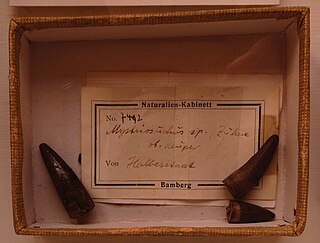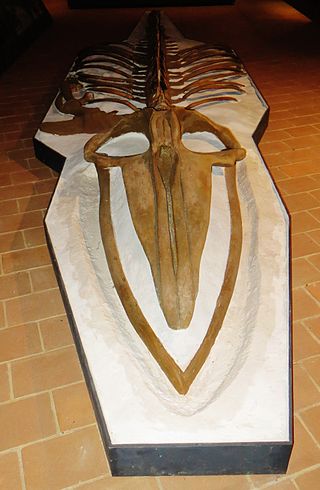
Taeniolabis is a genus of extinct multituberculate mammal from the Paleocene of North America.

Camarasaurus was a genus of quadrupedal, herbivorous dinosaurs and is the most common North American sauropod fossil. Its fossil remains have been found in the Morrison Formation, dating to the Late Jurassic epoch, between 155 and 145 million years ago.

Uintatherium is an extinct genus of herbivorous dinoceratan mammal that lived during the Eocene epoch. Two species are currently recognized: U. anceps from the United States during the Early to Middle Eocene and U. insperatus of Middle to Late Eocene China.

Belodon is a genus of phytosaur, a crocodile-like reptile that lived during the Triassic. Its fossils have been found in Europe and elsewhere. The type species, Belodon plieningeri, was named by prolific German paleontologist Christian Erich Hermann von Meyer in 1844.

Neosodon was a genus of sauropod dinosaur from the Late Tithonian-age Upper Jurassic Sables et Gres a Trigonia gibbosa of Pas-de-Calais department, France. It has never been formally given a species name, but is often seen as N. praecursor, which actually comes from a different animal. Often in the past, it had been assigned to the wastebasket taxon Pelorosaurus, but restudy has suggested that it could be related to Turiasaurus, a roughly contemporaneous giant Spanish sauropod. It is only known from six teeth.

Gravitholus was a genus of pachycephalosaurid dinosaur from the late Cretaceous period. It was a pachycephalosaur, and like other pachycephalosaurids the skull roof formed a thick dome made of dense bone, which may have been used in head-butting contests over mates or territory. It lived in what is now Alberta, Canada, and was described in 1979 by W. P. Wall and Peter Galton. The type species is Gravitholus albertae.
Suchoprion is a dubious genus of phytosaurian archosaur known from poor remains from the Late Triassic of North America. It was once thought to be a theropod dinosaur until 2013, when it was reclassified as a phytosaur.

Tomarctus is a canid genus of the extinct subfamily Borophaginae which inhabited most of North America during the late Early Miocene to the Early Barstovian age of the Middle Miocene. Tomarctus existed for approximately 6.83 million years.

Cimolichthys is an extinct genus of large predatory marine aulopiform ray-finned fish known worldwide from the Late Cretaceous. It is the only member of the family Cimolichthyidae.

Herpetotherium is an extinct genus of metatherian mammal, belonging to the possibly paraphyletic family Herpetotheriidae. Native to North America from the Eocene to Early Miocene, fossils have been found in California, Oregon, Texas, Florida, Montana, Wyoming, Colorado, North and South Dakota, Nebraska, and Saskatchewan. The oldest species, H. knighti, is dated to around 50.3 mya, and the most recent, an unnamed species, may be as recent as 15.97 mya. A morphological analysis of marsupials and basal metatherians conducted in 2007 found Herpetotherium to be the sister group to extant marsupials. It is the youngest known metatherian from North America until the migration of the Virginia opossum from South America within the last 2 million years.

Cheliderpeton is an extinct genus of temnospondyl amphibian. It lived during the Early Permian in what is now Europe. Fossils have been found from the Ruprechtice horizon of the Intrasudetic Basin of Bohemia in the Czech Republic, as well as the Saar-Nahe Basin of southwestern Germany. Cheliderpeton had a 16 cm skull, and reached about 65 cm in length.

Megalictis is an extinct genus of large predatory mustelids that existed in North America during the "cat gap" from the Late Arikareean (Ar4) in the Miocene epoch. It is thought to have resembled a huge, jaguar-sized ferret, weighing up to 60–100 kilograms (130–220 lb).

Oligobuninae is an extinct subfamily of the family Mustelidae known from Miocene deposits in North America.
Oligobunis is an extinct genus of mustelids, which existed during the Miocene epoch.
Promartes is a genus of mustelids, now extinct, which existed during the Miocene period.
Charactosuchus is an extinct genus of crocodilian. It was assigned to the family Crocodylidae in 1988. Specimens have been found in Colombia, Brazil, Jamaica, and possibly Florida and South Carolina. It was gharial-like in appearance with its long narrow snout but bore no relation to them, being more closely related to modern crocodiles than to gharials.

Trirachodon is an extinct genus of cynodonts. Fossils have been found in the Cynognathus Assemblage Zone of the Beaufort Group in South Africa and the Omingonde Formation of Namibia, dating back to the Early and Middle Triassic.

Leptosuchus is an extinct genus of leptosuchomorph phytosaur with a complex taxonomical history. Fossils have been found from the Dockum Group and lower Chinle Formation outcropping in Texas, New Mexico, and Arizona, United States, and date back to the Carnian stage of the Late Triassic.
Praenuculinae is an extinct subfamily of prehistoric bivalves in the family Praenuculidae. Praenuculinae species lived from the middle Ordovician through the late Devonian. Praenuculinae fossils are found in Europe, Africa, North America and South America, and species are thought to have been stationary attached to substrate in shallow infaunal marine water environments where they formed shells of an aragonite composition. The subfamily Praenuculinae was named by Teresa M. Sánchez in 1999.

Protororqualus is a genus of extinct rorqual from the late Pliocene of Mount Pulgnasco, Italy.





















